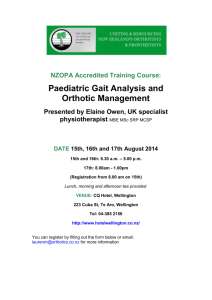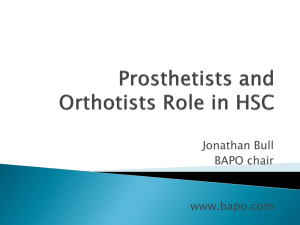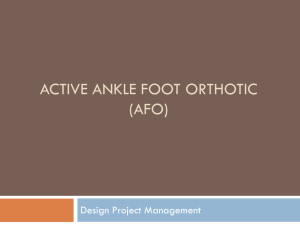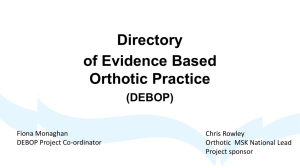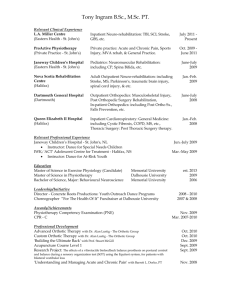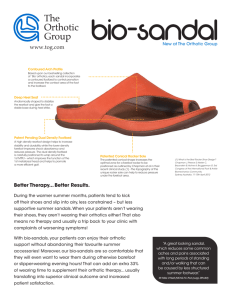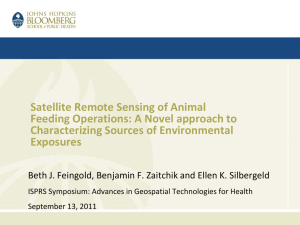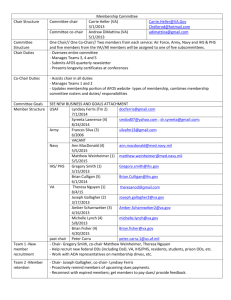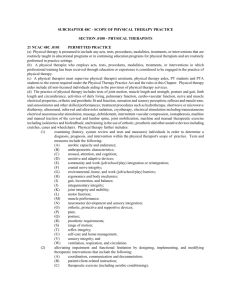User-friendly Ankle-foot orthotic (UFAFO)
advertisement
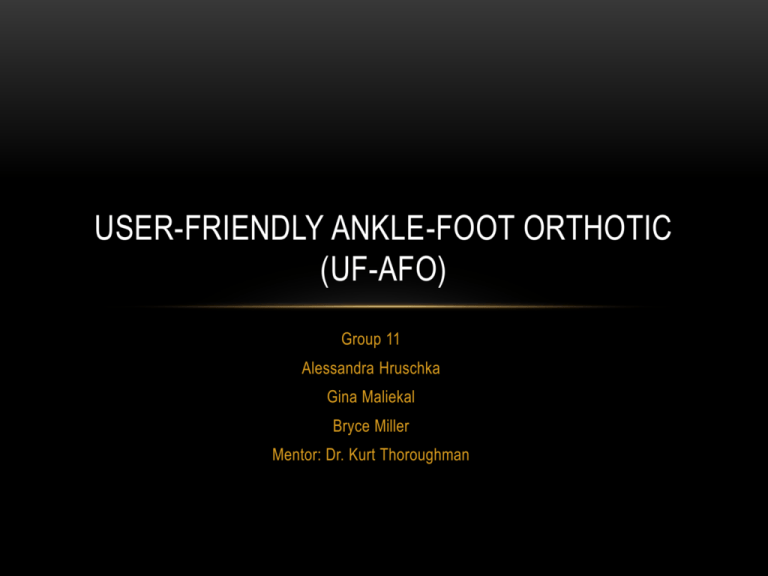
USER-FRIENDLY ANKLE-FOOT ORTHOTIC (UF-AFO) Group 11 Alessandra Hruschka Gina Maliekal Bryce Miller Mentor: Dr. Kurt Thoroughman OVERVIEW • Project Scope • Background • Existing Solutions • Need for Improvement • Design Specifications • Project Timeline • Team Organization PROJECT SCOPE To develop a fail-safe ankle-foot orthotic design that addresses the existing problem of patients and/or caregivers improperly positioning the device during daily use and notifies the patient and/or caregiver if the device is worn improperly. The changes made to existing orthotic design will not alter the treatment intended by the device’s use. Rather, the changes will facilitate faster placement and removal of the orthotic with fewer opportunities for user error. IRREGULAR GAIT CAUSES: CEREBRAL PALSY • Cerebral Palsy (CP), Polio, Spinal Cord Injury, Charcot-Marie-Tooth Syndrome and Strokes, Multiple Sclerosis • CP is “a non-progressive and non-hereditary disorder of motion and posture due to brain insult or injury occurring in the period of early brain growth” (M.S. Wong) • CP is one of the primary causes of irregular gait in children • 1.4-2.3% of the US population has CP • As of 2005, roughly 53,000 AFOs were prescribed yearly for children with CP (Figueiredo) NORMAL AND ABNORMAL GAIT ENERGY EXPENDITURE Ren 2007 CHARACTERIZATION: DYNAMIC FOOT PRESSURE Normal Clubfoot CHARACTERIZATION: 3D FOOT AND ANKLE MOTION ANALYSIS Forefoot: Severe Flatfoot ANKLE-FOOT ORTHOTIC (AFO) GOAL • Improved gait control and energy efficiency • Greater mobility • Functional independence and participation in society Orthotic & Prosthetic Design, Inc. TYPES OF AFOS Flexible AFOs, Rigid AFOs, Tamarack Flexure Joint and Anti-Talus AFOs are the categories standardized by the ICRC (International Committee of the Red Cross) in 2006. ICRC Manufacturing Guidelines 2006 EXAMPLES OF AFOS US Patent 7819832 US Patent Application 2003/0125653 MATERIALS & METHODS • Primary materials: polypropylene, polyethylene, and carbon fiber (older models made from leather and metal) • Methods: 1. Custom-made orthotics either by manual modeling from a positive or negative mold or computer-aided imaging 2. Off-the-shelf (prefabricated and sized) US Patent Application 2009/0306801 EVALUATION The success of prior art in the field of AFO design has been quantitatively evaluated in three independent respects or combinations thereof: • body function • structure level • activity level (Figueiredo 2008) NEED FOR IMPROVEMENT • AFOs are important for the treatment of CP but the user must comply with the instructions for effectiveness. • Appearance, fit and comfort are common reasons why a patient does not comply with instructions. • Interview with Dr. Neringa Juknis, Associate Professor of Neurology at Washington University School of Medicine in St. Louis • Unintentional user error is a reason for improper orthotic use (HKPU BME Summer Program 2011) DESIGN SPECIFICATIONS • Lightweight (mass < 1 kg or 35 ounces) • Easy to both don and doff (<60 seconds) • Low maintenance (daily care duration < 60 seconds) • Inconspicuous (acceptable appearance to children users below the age of 18) • Low cost (cost to user < $500) • Produces intended biomechanical treatment and uses existing materials • No loss of durability • Sensor detecting improper use PRELIMINARY SCHEDULE CURRENT TEAM ORGANIZATION • Alessandra Hruschka – AutoCAD Point Person, Progress Report Presenter, Biomechanics Researcher • Gina Maliekal – Preliminary Report Presenter, Field Research Point Person, Organizer • Bryce Miller – Final Reporter Presenter, Editor, Website Designer REFERENCES • US Patents: • US Patent Applications: • “Efficacy of Ankle-Foot Orthoses on Gait of Children with Cerebral Palsy: Systematic Review of Literature” Figueiredo et al. 2008. Pediatric Physical Therapy Journal. Volume 20 Issue 3. • Thanks to Dr. Neringa Juknis • M.S. Wong • ICRC Manufacturing Guidelines 2006 QUESTIONS?
